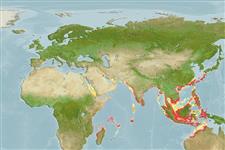>
Eupercaria/misc (Various families in series Eupercaria) >
Sillaginidae (Smelt-whitings)
Etymology: Sillago: From a locality in Australia.
Eponymy: In Greek mythology, Aeolos was the keeper of the winds and king of the mythical floating island of Aiolia. There is no etymology for the sillago, and the fish might be named after the meaning of the name Aeolos: ‘nimble’. (Ref. 128868), visit book page.
More on authors: Jordan & Evermann.
Environment: milieu / climate zone / depth range / distribution range
Sinh thái học
Biển gần đáy; không di cư; Mức độ sâu 0 - 60 m (Ref. 6205). Tropical; 34°N - 20°S, 35°E - 132°E (Ref. 6205)
Indo-Pacific: Singapore, Thailand, China, Hong Kong, Taiwan, Philippines, and southern Japan. Possibly distributed throughout the Indo-West Pacific from Delagoa Bay, South Africa to Okinawajima, Japan but not recorded from Australia or southern New Guinea. Very similar to Sillago burrus.
Length at first maturity / Bộ gần gũi / Khối lượng (Trọng lượng) / Age
Maturity: Lm 12.0 range ? - ? cm
Max length : 30.0 cm SL con đực/không giới tính; (Ref. 6205)
Các tia vây lưng cứng (tổng cộng) : 12; Các vây lưng mềm (tổng cộng) : 18 - 20; Tia cứng vây hậu môn: 2; Tia mềm vây hậu môn: 17 - 19; Động vật có xương sống: 34. Swim bladder with three rudimentary anterolateral extensions instead of four; differs from S. maculata in lacking well developed anterolateral extensions reaching to level of vent. Body color is silvery with scattered dark brown elongate blotches on the sides.
Occur in inshore coastal waters, commonly in embayments on silty bottoms (Ref. 9679). Juveniles have been known to burrow in the sand (Ref. 6208). Oviparous (Ref. 205), multiple spawner (Ref. 56320). Small local fisheries exist throughout the range of the species. The flesh is prone to spoil rapidly and the Oriental sillago is not considered as highly as the inshore sillaginids (Ref. 6205). S. aeolus has not been found in association with S. burrus or S. maculata.
McKay, R.J., 1992. FAO Species Catalogue. Vol. 14. Sillaginid fishes of the world (family Sillaginidae). An annotated and illustrated catalogue of the sillago, smelt or Indo-Pacific whiting species known to date. Rome: FAO. FAO Fish. Synop. 125(14):87p. (Ref. 6205)
IUCN Red List Status (Ref. 130435: Version 2024-2)
Threat to humans
Harmless
Human uses
Các nghề cá: buôn bán nhỏ
Các công cụ
Special reports
Download XML
Các nguồn internet
Estimates based on models
Preferred temperature (Ref.
123201): 25.2 - 29.1, mean 28.5 °C (based on 1092 cells).
Phylogenetic diversity index (Ref.
82804): PD
50 = 0.5000 [Uniqueness, from 0.5 = low to 2.0 = high].
Bayesian length-weight: a=0.00617 (0.00362 - 0.01050), b=3.05 (2.90 - 3.20), in cm total length, based on LWR estimates for this species & Genus-body shape (Ref.
93245).
Mức dinh dưỡng (Ref.
69278): 3.3 ±0.4 se; based on size and trophs of closest relatives
Thích nghi nhanh (Ref.
120179): Chiêù cao, thời gian nhân đôi của chủng quần tối thiểu là dưới 15 tháng (Fec = 11,131).
Fishing Vulnerability (Ref.
59153): Low to moderate vulnerability (27 of 100).
